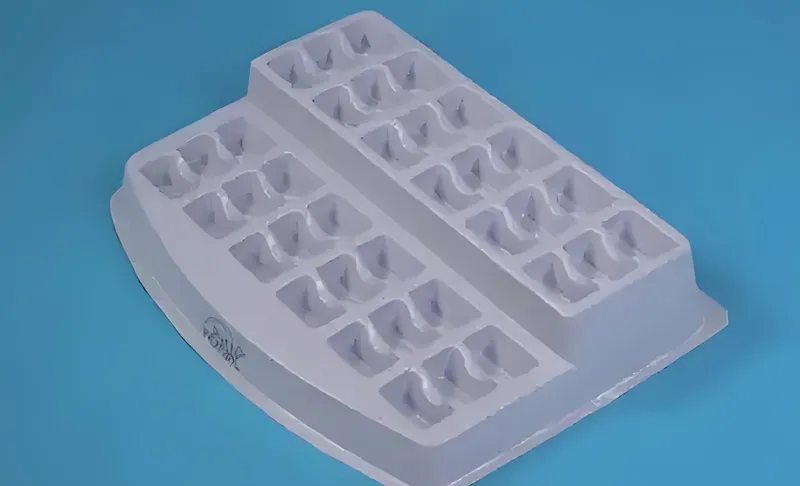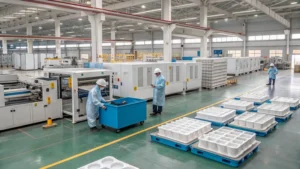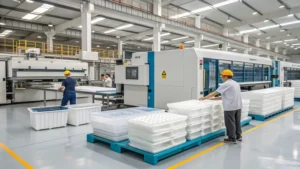
The thermoforming process shapes plastic sheets into lightweight, durable products by heating and molding them, making it essential for industries like packaging, automotive, and medical, where cost efficiency is key.
Thermoforming heats plastic sheets and molds them into products for packaging, automotive, and medical uses, with cost reduction achievable through material optimization, process efficiency, and automation.
Understanding how to reduce costs in thermoforming can significantly enhance your production efficiency and competitiveness. Explore the methods below to see how they can be applied to your operations.
Thermoforming is only cost-effective for low-volume production.False
While thermoforming has lower tooling costs, making it ideal for low to medium volumes, it can also be cost-effective for high volumes with optimized processes.
Material selection is the most critical factor in reducing thermoforming costs.True
Choosing the right material, such as recycled plastics, can significantly lower material expenses without compromising quality.
- 1. What are the Common Cost Reduction Methods in Thermoforming?
- 2. How Does Material Optimization Reduce Costs in Thermoforming?
- 3. What are the Steps to Improve Process Efficiency in Thermoforming?
- 4. How Does Automation Contribute to Cost Reduction in Thermoforming?
- 5. What are the Key Design Considerations for Cost Reduction in Thermoforming?
- 6. How Do Tooling Improvements Impact Costs in Thermoforming?
- 7. What are the Strategies for Energy Efficiency in Thermoforming?
- 8. How Does Outsourcing Contribute to Cost Reduction in Thermoforming?
- 9. Conclusion
What are the Common Cost Reduction Methods in Thermoforming?
Cost reduction in thermoforming1 is crucial for maintaining competitiveness, and several methods can help achieve this goal.

Common cost reduction methods in thermoforming include material optimization, process efficiency, automation, design for manufacture, tooling improvements, energy efficiency, and outsourcing.
| Method | Key Benefit | Application Example |
|---|---|---|
| Material Optimization2 | Lower material costs | Using recycled plastics |
| Process Efficiency3 | Reduced cycle times | Optimized heating systems |
| Automation | Lower labor costs | Robotic part handling |
| Design for Manufacture | Minimized waste | Uniform wall thickness |
| Tooling Improvements | Longer mold lifespan | High-quality mold materials |
| Energy Efficiency | Reduced energy consumption | Infrared heaters |
| Outsourcing | Lower labor costs | Partnering with low-cost regions |
Material Optimization
Material optimization involves selecting cost-effective plastics or using recycled materials to reduce expenses. For instance, in packaging, recycled polystyrene (PS)4 can be used instead of virgin PS, cutting material costs by up to 20%.

Process Efficiency
Improving process efficiency focuses on reducing cycle times through better heating and cooling techniques. Implementing infrared heaters can provide uniform heating, shortening the time to reach forming temperature.
Automation
Automation reduces labor costs by using robotics for tasks like part removal and trimming. This not only cuts costs but also improves precision and consistency.
Design for Manufacture
Designing parts with thermoforming in mind—such as ensuring uniform wall thickness—minimizes material waste and simplifies the forming process, leading to cost savings.

Tooling Improvements
Investing in high-quality molds made from durable materials like aluminum alloys can reduce maintenance and replacement costs, offering long-term savings.
Energy Efficiency
Energy-efficient technologies, such as advanced heating systems and heat recovery, can significantly lower energy consumption, a major cost factor in thermoforming.
Outsourcing
Outsourcing to regions with lower labor costs can reduce production expenses, though it requires careful management of logistics and quality control.
Automation in thermoforming always leads to higher initial costs.False
While automation requires upfront investment, it often results in long-term savings through reduced labor and increased efficiency.
Outsourcing thermoforming production can compromise quality.False
With proper quality control measures, outsourcing can maintain high standards while reducing costs.
How Does Material Optimization Reduce Costs in Thermoforming?
Material optimization is a key strategy for reducing costs in thermoforming by selecting affordable yet effective plastics or incorporating recycled materials.
Material optimization in thermoforming reduces costs by using recycled or lower-cost plastics, especially in non-critical applications like packaging, where material expenses can drop by up to 20%.

Choosing Cost-Effective Materials
Selecting materials like recycled polystyrene (PS) or polypropylene (PP) can significantly lower material costs. For example, in blister packaging, using recycled PET instead of virgin PET can reduce expenses while maintaining functionality.
Impact on Production
Using recycled materials may require adjustments in processing parameters, such as temperature and cycle time, but the cost savings often outweigh these minor changes. Additionally, some materials like high-impact polystyrene (HIPS) offer durability at a lower cost, making them ideal for automotive applications.
Table: Material Cost Comparison
| Material | Cost per kg (Virgin) | Cost per kg (Recycled) | Savings (%) |
|---|---|---|---|
| Polystyrene (PS) | $1.50 | $1.20 | 20% |
| Polypropylene (PP) | $1.80 | $1.44 | 20% |
| PET | $2.00 | $1.60 | 20% |
Recycled materials are always suitable for thermoforming.False
While recycled materials can reduce costs, they may not meet the quality standards for certain applications, such as medical devices.
Material optimization can lead to significant cost savings without compromising product quality.True
By carefully selecting materials based on application requirements, manufacturers can reduce costs while maintaining performance.
What are the Steps to Improve Process Efficiency in Thermoforming?
Improving process efficiency in thermoforming5 is essential for reducing production costs and increasing output.
To improve process efficiency in thermoforming, optimize heating and cooling systems, reduce cycle times, and implement lean manufacturing principles6.

Optimize Heating Systems
Using advanced heating technologies like infrared heaters ensures uniform heating, reducing the time needed to reach the forming temperature. This can cut cycle times by up to 15%, directly lowering energy and labor costs.
Enhance Cooling Techniques
Efficient cooling systems, such as water-cooled molds, can speed up the cooling process, allowing for faster production rates. For example, a study showed that optimized cooling reduced cycle times by 10% in automotive part production.
Implement Lean Manufacturing
Lean principles, such as minimizing waste and streamlining workflows, can further enhance efficiency. By reducing setup times and eliminating unnecessary steps, manufacturers can increase throughput and reduce costs.
Process efficiency improvements always require significant capital investment.False
While some improvements may require investment, others, like lean manufacturing techniques, can be implemented with minimal cost.
Optimized heating and cooling can reduce cycle times by up to 15%.True
Advanced heating technologies and efficient cooling systems directly impact cycle times, leading to higher productivity.
How Does Automation Contribute to Cost Reduction in Thermoforming?
Automation plays a crucial role in reducing costs in thermoforming by minimizing labor expenses and increasing precision.
Automation in thermoforming7 reduces costs by replacing manual labor with robotics for tasks like part handling and trimming, leading to labor savings of up to 30%.

Types of Automation
Robotic arms are commonly used for part removal, stacking, and trimming, reducing the need for manual intervention. Automated quality control systems8 can also detect defects early, preventing costly rework.
Cost Savings Analysis
While automation requires an initial investment, the long-term savings can be substantial. For instance, a thermoforming plant implementing robotic trimming reported a 25% reduction in labor costs within the first year.
Table: Automation Cost Savings
| Automation Type | Initial Investment | Annual Labor Savings | Payback Period |
|---|---|---|---|
| Robotic Part Handling | $50,000 | $15,000 | 3.3 years |
| Automated Trimming | $70,000 | $20,000 | 3.5 years |
Automation in thermoforming is only beneficial for large-scale production.False
Even small to medium-sized operations can benefit from automation by improving efficiency and reducing labor costs.
Automation can lead to a 25% reduction in labor costs.True
By automating repetitive tasks, manufacturers can significantly cut labor expenses while maintaining production quality.
What are the Key Design Considerations for Cost Reduction in Thermoforming?
Designing parts with thermoforming in mind is essential for minimizing waste and simplifying the manufacturing process.
Key design considerations for cost reduction in thermoforming include uniform wall thickness, avoiding undercuts, and minimizing trimming requirements.

Uniform Wall Thickness
Designing parts with consistent wall thickness ensures even material distribution, reducing the risk of defects and minimizing material usage. This can lead to material savings of up to 10%.
Avoiding Undercuts
Undercuts complicate the forming process and may require additional tooling or manual intervention, increasing costs. Designing parts without undercuts simplifies production and reduces expenses.
Minimizing Trimming
By designing parts to require minimal trimming, manufacturers can reduce post-processing time and labor costs. For example, a well-designed blister pack can reduce trimming waste by 15%.
Designing for thermoforming always increases initial design costs.False
While design optimization may require upfront effort, it leads to long-term savings through reduced waste and simplified production.
Uniform wall thickness can reduce material usage by up to 10%.True
Consistent thickness ensures efficient material distribution, minimizing excess usage.
How Do Tooling Improvements Impact Costs in Thermoforming?
Investing in high-quality tooling can lead to significant cost savings9 over time by reducing maintenance and replacement expenses.
Tooling improvements in thermoforming, such as using durable mold materials, reduce costs by extending mold lifespan and minimizing downtime.

Durable Mold Materials
Using materials like aluminum alloys for molds offers better heat transfer and durability compared to traditional materials, reducing the frequency of mold replacements.
Optimized Mold Design
Designing molds with efficient cooling channels can speed up the production process, lowering energy costs and increasing output.
Table: Mold Material Comparison
| Mold Material | Lifespan (cycles) | Cost per Mold | Cost per Part |
|---|---|---|---|
| Aluminum Alloy | 100,000 | $10,000 | $0.10 |
| Epoxy Resin | 10,000 | $2,000 | $0.20 |
High-quality molds always lead to higher initial costs.True
While durable molds are more expensive upfront, they reduce long-term costs by minimizing replacements and downtime.
Optimized mold design can reduce energy costs by improving cooling efficiency.True
Efficient cooling channels allow for faster cycle times, directly lowering energy consumption.
What are the Strategies for Energy Efficiency in Thermoforming?
Energy efficiency is critical in thermoforming, as heating plastic sheets is energy-intensive.
Strategies for energy efficiency in thermoforming include using advanced heating systems10, insulating equipment, and recovering waste heat.

Advanced Heating Systems
Infrared heaters provide uniform heating, reducing energy waste and shortening cycle times. This can lead to energy savings of up to 15%.
Insulating Equipment
Proper insulation of heating elements and molds prevents heat loss, ensuring that energy is used efficiently.
Heat Recovery
Recovering waste heat from the process can be used to preheat incoming materials, further reducing energy consumption.
Energy-efficient technologies always require significant investment.False
Some strategies, like insulating equipment, can be implemented at low cost, while others may require investment but offer substantial savings.
Advanced heating systems can reduce energy consumption by up to 15%.True
Uniform heating technologies minimize energy waste, directly lowering operational costs.
How Does Outsourcing Contribute to Cost Reduction in Thermoforming?
Outsourcing thermoforming production to regions with lower labor costs can significantly reduce expenses, but it requires careful management.
Outsourcing in thermoforming reduces costs by leveraging lower labor rates in regions like Asia or Eastern Europe, potentially saving 20-30% on production expenses.

Pros and Cons
While outsourcing can lower labor costs, it may introduce challenges like longer lead times, quality control issues, and logistical complexities. Companies must weigh these factors against the cost savings.
Quality Control
Implementing strict quality control measures, such as regular audits and clear specifications, is essential to maintain product standards when outsourcing.
Outsourcing always results in lower quality products.False
With proper oversight and quality control, outsourcing can maintain high standards while reducing costs.
Outsourcing can save up to 30% on labor costs.True
Regions with lower labor rates offer significant savings, especially for labor-intensive processes like trimming and finishing.
Conclusion
Cost reduction in the thermoforming industry is achievable through a combination of material optimization, process efficiency, automation, design improvements, tooling enhancements, energy efficiency11, and strategic outsourcing. By implementing these methods, manufacturers can significantly lower production costs while maintaining or even improving product quality. For instance, using recycled materials can cut material expenses by up to 20%, while automation can reduce labor costs by 30%. Energy-efficient technologies and optimized designs further contribute to savings, making thermoforming a more competitive and sustainable manufacturing process.
-
Discover innovative strategies to reduce costs in thermoforming, enhancing your production efficiency and competitiveness. ↩
-
Learn how material optimization can lead to significant cost savings and improved sustainability in your thermoforming processes. ↩
-
Explore best practices for enhancing process efficiency in thermoforming, which can lead to reduced cycle times and increased productivity. ↩
-
Learn about the applications and advantages of using recycled polystyrene in packaging to reduce costs and environmental impact. ↩
-
Explore this resource to discover effective strategies and technologies that can enhance efficiency in thermoforming processes. ↩
-
Learn how lean manufacturing can streamline operations and reduce waste, leading to significant cost savings and efficiency gains. ↩
-
This link will provide insights into how automation can transform thermoforming, reducing costs and increasing precision in production. ↩
-
Explore how automated quality control systems can enhance efficiency and reduce defects in manufacturing processes. ↩
-
Learn about the various ways automation can lead to significant cost savings in manufacturing and other industries. ↩
-
Discover how advanced heating systems can optimize production efficiency and reduce energy waste, making your thermoforming operations more effective. ↩
-
Exploring this resource will provide insights into innovative techniques that can enhance energy efficiency in thermoforming processes, leading to cost savings and sustainability. ↩








